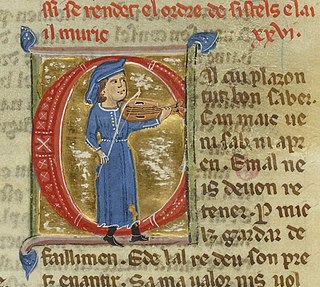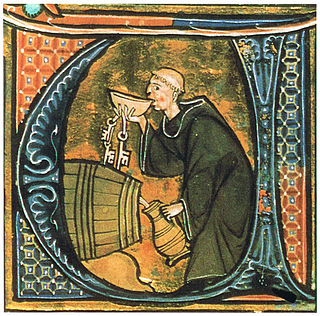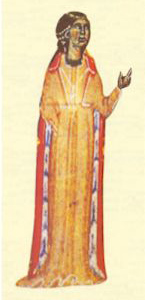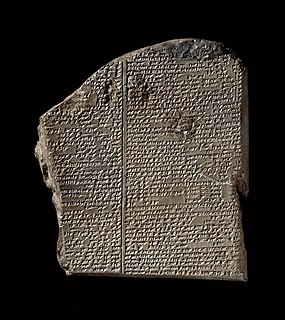Related Research Articles

In western music, a motet is a mainly vocal musical composition, of highly diverse form and style, from the late medieval era to the present. The motet was one of the pre-eminent polyphonic forms of Renaissance music. According to Margaret Bent, "a piece of music in several parts with words" is as precise a definition of the motet as will serve from the 13th to the late 16th century and beyond. The late 13th-century theorist Johannes de Grocheo believed that the motet was "not to be celebrated in the presence of common people, because they do not notice its subtlety, nor are they delighted in hearing it, but in the presence of the educated and of those who are seeking out subtleties in the arts".

A troubadour was a composer and performer of Old Occitan lyric poetry during the High Middle Ages (1100–1350). Since the word troubadour is etymologically masculine, a female troubadour is usually called a trobairitz.

Cædmon is the earliest English poet whose name is known. A Northumbrian who cared for the animals at the double monastery of Streonæshalch during the abbacy of St. Hilda, he was originally ignorant of "the art of song" but learned to compose one night in the course of a dream, according to the 8th-century historian Bede. He later became a zealous monk and an accomplished and inspirational Christian poet.

The Archpoet, or Archipoeta, is the name given to an anonymous 12th-century author of ten medieval Latin poems, the most famous being his "Confession" found in the Carmina Burana manuscript. Along with Hugh Primas of Orléans, he is cited as the best exemplar of Goliardic poetry and one of the stellar poets of the Latin Middle Ages.

The trobairitz were Occitan female troubadours of the 12th and 13th centuries, active from around 1170 to approximately 1260. Trobairitz is both singular and plural.
Ordo Virtutum is an allegorical morality play, or sacred music drama, by St. Hildegard, composed c. 1151, during the construction and relocation of her Abbey at Rupertsberg. It is the earliest morality play by more than a century, and the only Medieval musical drama to survive with an attribution for both the text and the music.

Hadewijch was a 13th-century poet and mystic, probably living in the Duchy of Brabant. Most of her extant writings are in a Brabantian form of Middle Dutch. Her writings include visions, prose letters and poetry. Hadewijch was one of the most important direct influences on John of Ruysbroeck.

Poetry as an art form predates written text. The earliest poetry is believed to have been recited or sung, employed as a way of remembering oral history, genealogy, and law. Poetry is often closely related to musical traditions, and the earliest poetry exists in the form of hymns, and other types of song such as chants. As such poetry is a verbal art. Many of the poems surviving from the ancient world are recorded prayers, or stories about religious subject matter, but they also include historical accounts, instructions for everyday activities, love songs, and fiction. Many scholars, particularly those researching the Homeric tradition and the oral epics of the Balkans, suggest that early writing shows clear traces of older oral traditions, including the use of repeated phrases as building blocks in larger poetic units. A rhythmic and repetitious form would make a long story easier to remember and retell, before writing was available as a reminder. Thus many ancient works, from the Vedas to the Odyssey, appear to have been composed in poetic form to aid memorization and oral transmission, in prehistoric and ancient societies. Poetry appears among the earliest records of most literate cultures, with poetic fragments found on early monoliths, runestones and stelae.
A genre of the troubadours, the planh or plaing is a funeral lament for "a great personage, a protector, a friend or relative, or a lady." Its main elements are expression of grief, praise of the deceased (eulogy) and prayer for his or her soul. It is descended from the medieval Latin planctus.

Roman Catholic Marian music shares a trait with some other forms of Christian music in adding another emotional dimension to the process of veneration and in being used in various Marian ceremonies and feasts. Marian music is now an inherent element in many aspects of the veneration of the Blessed Virgin Mary in Roman Catholic Mariology.
The Verses pascales de tres Maries are twelfth-century Latin lyric verses from Vic that form a liturgical drama for performance at Easter. The play, by an anonymous cleric, is highly original in content and form, though it only runs ninety-four lines.
Sponsus or The Bridegroom is a medieval Latin and Occitan dramatic treatment of Jesus' parable of the ten virgins. A liturgical play designed for Easter Vigil, it was composed probably in Gascony or western Languedoc in the mid-eleventh century. Its scriptural basis is found in the Gospel of Matthew (25:1–13), but it also draws on the Song of Songs and the Patristics, perhaps Jerome's Adversus Jovinianum. In certain respects—the portrayal of the merchants, the spilling of the oil, the implicit questioning of accepted theodicy—it is original and dramatically powerful.
Augats, seyós qui credets Déu lo Payre is a Catalan poem of lamentation (planctus) in the planctus Mariae tradition, in which the Virgin Mary laments the death of her son. It was written between 1240 and 1260 and is thus one of the oldest Catalan poems, although it is comes two hundred years after the Cançó de Santa Fe. The piece is sometimes confused with the Plant de la Verge of Ramon Llull.
The Planctus (de obitu) Karoli, also known by its incipit A solis ortu, is an anonymous medieval Latin planctus eulogising Charlemagne, written in accented verse by a monk of Bobbio shortly after his subject's death in 814. It is generally considered the earliest surviving planctus, though its melody is written in tenth-century neumes, one of the earliest surviving examples of this sort of musical notation. The poem has been translated into English by Peter Godman.
The Swan Sequence is an anonymous Carolingian-Aquitainian Latin poem sequence first written around 850. Its melody, Planctus cygni, was popular for some two centuries after its composition.
Angelbert was a Frankish soldier and poet, possibly from Aquitaine. His "Verses on the Battle that was Fought at Fontenoy" are a first-hand description of the Battle of Fontenoy of 25 June 841, in which he participated with the army of Lothair I. They are an important piece of battle literature from the twilight of the Carolingian Renaissance. Historian Bernard Bachrach has examined them as a source for the emotional effects of battle during the ninth century.
Foebus abierat is a medieval Latin poem, authorship unknown, composed near the end of the 10th century in Northern Italy. Described as "hauntingly beautiful" and "one of the joys of medieval poetry," it is an erotic dream-vision lyric spoken by a woman who grieves the departure of her lover Phoebus, brother of the Moon. Although the language is ecclesiastical Latin, none of its content is explicitly Christian.

Peter Abelard (; Latin: Petrus Abaelardus or Abailardus; was a medieval French scholastic philosopher, leading logician, theologian, teacher, musician, composer, and poet.
A sentimental ballad is an emotional style of music that often deals with romantic and intimate relationships, and to a lesser extent, loneliness, death, war, drug abuse, politics and religion, usually in a poignant but solemn manner. Ballads are generally melodic enough to get the listener's attention.
Hymnody in continental Europe developed from early liturgical music, especially Gregorian chant. Music became more complicated as embellishments and variations were added, along with influences from secular music. Although vernacular leisen and vernacular or mixed-language Carol (music) were sung in the Middle Ages, more vernacular hymnody emerged during the Protestant Reformation, although ecclesiastical Latin continued to be used after the Reformation. Since then, developments have shifted between isorhythmic, homorhythmic, and more rounded musical forms with some lilting. Theological underpinnings influenced the narrative point of view used, with Pietism especially encouraging the use of the first person singular. In the last several centuries, many songs from Evangelicalism have been translated from English into German.
References
- Stevens, John (2001). "Planctus". In Root, Deane L. (ed.). The New Grove Dictionary of Music and Musicians . Oxford University Press.